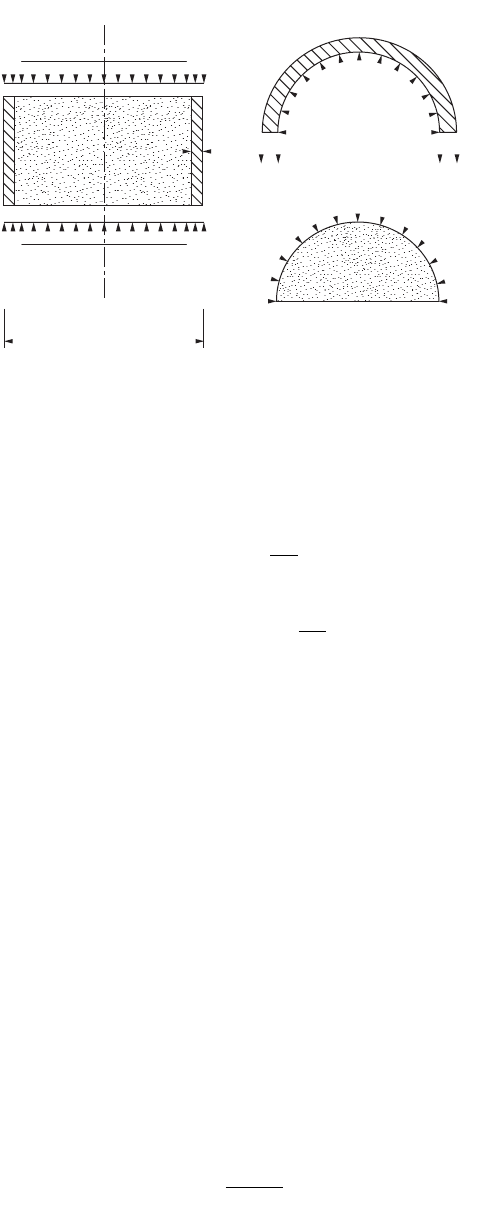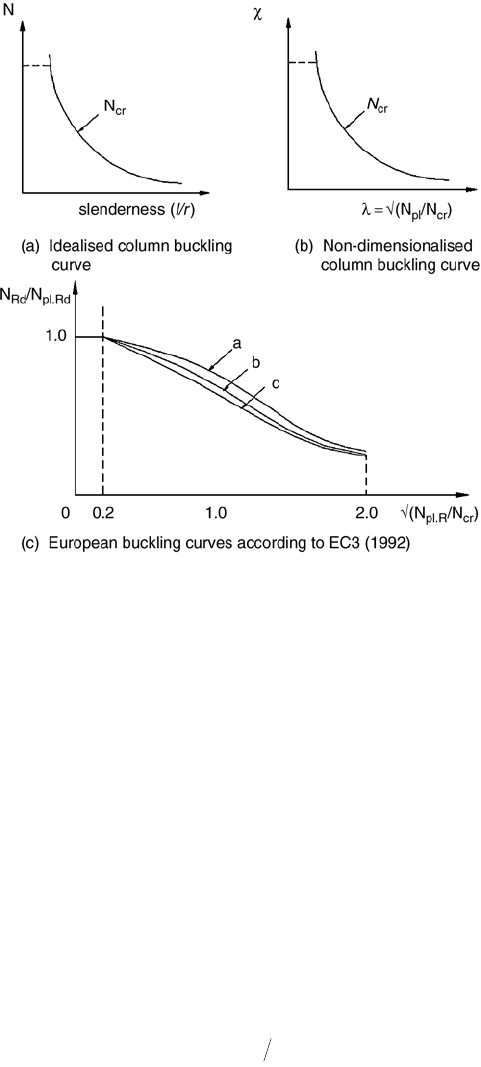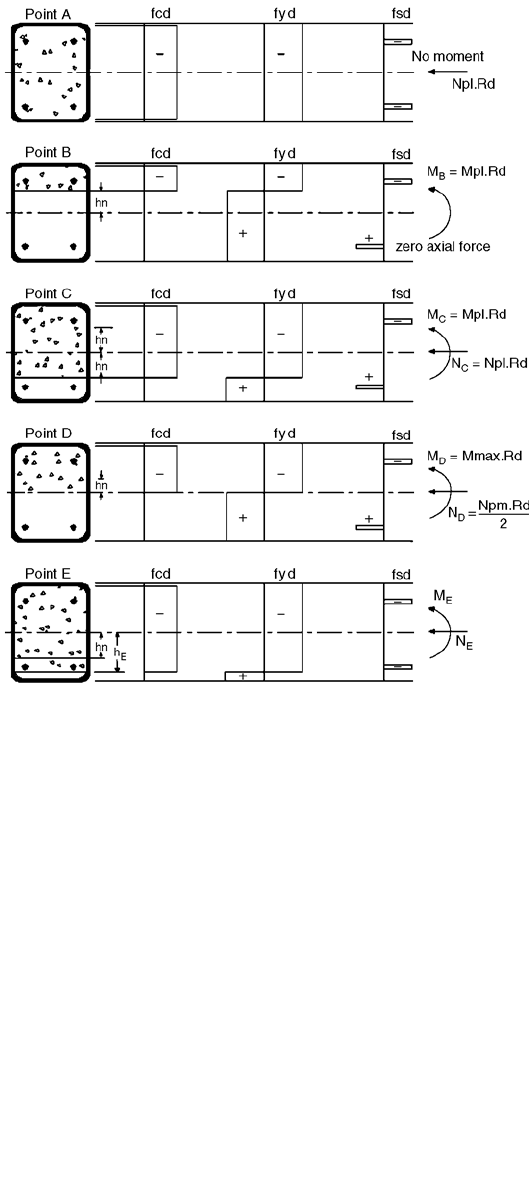Wai-Fah Chen.The Civil Engineering Handbook
Подождите немного. Документ загружается.


51-30 The Civil Engineering Handbook, Second Edition
Plastic Neutral Axis in the Steel Beam (Full Shear Connection, = 1.0)
When the steel beam is stronger than the reinforcing steel, the plastic neutral axis for the beam with full
shear connection will lie within the steel beam. For this case it is more convenient to sum the moments
about the centroid of the compression force, as illustrated in Fig. 51.34.
M
u
= T
s
L
s
+ T
r
L
r
(51.39)
Partial Shear Connection ( < 1.0)
Although not generally allowed by international codes of practice, partial shear connection in the negative
moment region may need to be considered for special cases. For the case of partial shear connection of
composite beams in hogging bending, the shear connection is the weakest. Again, summing the moments
on a convenient point on the cross section will yield the ultimate flexural moment of the beam.
M
u
= T
s
L
s
+ T
r
L
r
(51.40)
Ductility
The assumption of a plastic collapse mechanism in continuous composite beams will generally be
dependent on the formation of hinges at both the sagging and hogging regions. Oehlers and Bradford [3]
have shown that when the ductility parameter c > 1.6, a plastic mechanism will be formed. The ductility
parameter is determined as
(51.41)
51.8 Composite Columns
The design of composite columns requires the consideration of both short-column and slender-column
behavior. In addition, bending moments, which may occur about either axis due to imperfections and
applied loading, must be considered. This section will consider the existing codes for the design of
composite columns. The most comprehensive method is the Eurocode 4 approach, followed by the
AISC-LRFD [28] approach. An Australian approach incorporating AS 3600 and AS 4100 [29] will also
be considered herein.
FIGURE 51.34 Ultimate flexural moment, plastic neutral axis in steel beam (b = 1.0).
FIGURE 51.35 Ultimate flexural moment, partial shear connection (b < 1.0).
c
e
ee
=
+
()
+
()
085. fb h h
Af
ccu conc steel
steel y u st
© 2003 by CRC Press LLC

Composite Steel–Concrete Structures 51-31
Eurocode 4
Resistance of the Cross Section to Compression
The plastic resistance to compression of a composite cross section represents the maximum load that
can be applied to a short composite column. It is important to recognize that concrete-filled circular
hollow sections exhibit enhanced resistance due to the triaxial containment effects. Fully or partially
concrete-encased steel sections and concrete-filled rectangular sections do not achieve such enhancement.
Hence these two categories are dealt with separately in EC4.
Encased Steel Sections and Concrete-Filled Rectangular Hollow Sections
The plastic resistance of an encased steel section or a concrete-filled rectangular or square hollow section
is given by the sum of the resistances of the components as follows:
(51.42)
where A
a
, A
c
, and A
s
= the cross-sectional areas of the structural section, the concrete, and the rein-
forcing steel, respectively
f
y
, f
ck
, and f
sk
= the yield strength of the steel section, the characteristic compressive strength of
the concrete, and the yield strength of the reinforcing steel, respectively
g
a
, g
c
, and g
s
= the partial safety factors at the ultimate limit state (g
a
= 1.10, g
c
= 1.5, and g
s
=
1.15)
a
c
= the strength coefficient for concrete, 1.0 for concrete-filled hollow sections and
0.85 for fully and partially concrete-encased steel sections.
For ease of expression, f
y
/g
a
, a
c
f
ck
/g
c
, and f
sk
/g
s
are presented as the design strengths of the respective
materials, such as f
yd
, f
cd
, and f
sd
. Equation (51.42) can therefore be rewritten as follows:
N
pl.Rd
= A
a
f
yd
+ A
c
f
cd
+ A
s
f
sd
(51.43)
An important design parameter, d, the steel contribution ratio, is defined as follows:
(51.44)
The column is classified as composite if the steel contribution ratio falls within the range of 0.2 £ d £
0.9. If d is less than 0.2, the column shall be designed as a reinforced concrete column; otherwise, if d is
greater than 0.9, the column shall be designed as a bare steel column.
Concrete-Filled Circular Hollow Sections
For concrete-filled circular hollow sections, the load-bearing capacity of the concrete can be increased
due to the confinement effect from the surrounding tube. This effect is shown in Fig. 51.36. When a
concrete-filled circular section is subjected to compression, causing the Poisson’s expansion of the con-
crete to exceed that of steel, the concrete is triaxially confined by the axial forces associated with the
development of hoop tension in the steel section. The development of these hoop tensile forces in the
tube, combined with the compressive axial forces in the steel shell, lowers the effective plastic resistance
of the steel section in accordance with the von Mises failure criteria. However, the increase in concrete
strength over the normal unconfined cylinder strength often more than offsets any reduction in the
resistance of the steel. The net effect is that such columns show an enhanced strength.
The plastic resistance of the cross section of a concrete-filled circular hollow section is given by:
(51.45)
NAf Af Af
pl Rd a y a c c ck c s sk s.
=+ +ga g g
d=
Af
N
ayd
pl Rd.
NA
f
A
f
td
f
f
A
f
pl Rd a
y
a
c
ck
c
y
ck
s
sk
s
.
=++
()
Ê
Ë
Á
ˆ
¯
˜
+h
gg
h
g
21
1
© 2003 by CRC Press LLC

51-32 The Civil Engineering Handbook, Second Edition
The concrete enhancement effect is included in the bracket term associated with the concrete component
term in Eq. (51.45). The hoop stress effect is reflected by the h
2
factor in the steel component term. Other
parameters given in Eq. (51.45) are defined as follows: t is the thickness of the circular hollow section,
(51.46)
(51.47)
A linear interpolation is carried out for load eccentricity, e £ d/10, with the basic values h
10
and h
20
,
which depend on the relative slenderness l:
(51.48)
(51.49)
No reinforcement is necessary for concrete infilled sections; however, if the contribution from rein-
forcement is to be considered in the load-bearing capacity, the ratio of reinforcement should fall within
the range of 0.3% £ A
s
/A
c
£ 4%. Additional reinforcement may be necessary for fire resistance design,
but shall not be taken into account if the ratio exceeds 4%.
The effects of triaxial containment tend to diminish as the column length increases. Consequently,
this effect may only be considered up to a relative slenderness of l £ 0.5. For most practical columns the
value of l of 0.5 corresponds to a length-to-diameter ratio (l/d) of approximately 12. In addition, the
eccentricity of the normal force, e, may not exceed the value d/10, d being the outer diameter of the
circular hollow steel section. If the eccentricity, e, exceeds the value d/10, or if the nondimensional
slenderness l exceeds the value 0.5, then h
1
= 0 and h
2
= 1.0 must be applied, and Eq. (51.45) reduces
to Eq. (51.42).
The eccentricity, e, is defined by:
(51.50)
FIGURE 51.36 Effect of concrete confinement.
s
c
s
c
d
s
a
s
a
s
r
s
j
s
r
hh
110
1
10
=-
Ê
Ë
Á
ˆ
¯
˜
e
d
hh h
220 20
1
10
=+-
()
e
d
hll
10
2
49 185 1700=- + ≥.. .
hl
20
025 3 2 10=+
()
£. .
e
M
N
Sd
Sd
=
max,
© 2003 by CRC Press LLC

Composite Steel–Concrete Structures 51-33
where M
max,Sd
= the maximum design moment from first-order analysis
N
Sd
= the design axial force
Table 51.5 gives the basic values h
10
and h
20
for different values of l. It should be noted that the
evaluation of N
pl.Rd
for concrete-filled circular hollow sections always starts with Clause 4.8.3.3(1), with
unity material factors to give l, and thus it is not an iteration process.
From a numerical study carried out by Bergmann et al. [30], the application of Eqs. (51.45) to (51.49)
and its relation to Eq. (51.43) is shown in Table 51.6. The table gives the respective increase in the axial
TABLE 51.5 Basic Values h
10
and h
20
to
Allow for the Effect of Triaxial Confinement
in Concrete-Filled Circular Hollow Sections
l 0.0 0.1 0.2 0.3 0.4 0.5
h
10
4.9 3.22 1.88 0.88 0.22 0.0
h
20
0.75 0.80 0.85 0.90 0.95 1.00
TABLE 51.6 Increase in Resistance to Axial Loads for Different Ratios of d/t, f
y
/f
ck
,
and Selected Values for e/d and l Due to Confinement
40 60 80
d/t f
y
/f
ck
f
y
/f
ck
f
y
/f
ck
l e/d 510155101551015
0.0 0.00 1.152 1.238 1.294 1.114 1.190 1.244 1.090 1.157 1.207
0.01 1.137 1.215 1.264 1.102 1.171 1.220 1.081 1.141 1.186
0.02 1.122 1.191 1.235 1.091 1.152 1.195 1.072 1.125 1.166
0.03 1.107 1.167 1.206 1.080 1.133 1.171 1.063 1.110 1.145
0.04 1.091 1.143 1.176 1.068 1.114 1.146 1.054 1.094 1.124
0.05 1.076 1.119 1.149 1.057 1.095 1.122 1.045 1.078 1.103
0.06 1.061 1.095 1.118 1.045 1.076 1.098 1.036 1.063 1.083
0.07 1.046 1.072 1.088 1.034 1.057 1.073 1.027 1.047 1.062
0.08 1.030 1.048 1.059 1.023 1.038 1.049 1.018 1.031 1.041
0.09 1.015 1.024 1.029 1.011 1.019 1.024 1.009 1.016 1.021
0.2 0.00 1.048 1.075 1.093 1.036 1.060 1.078 1.029 1.050 1.066
0.01 1.043 1.068 1.083 1.033 1.054 1.070 1.026 1.045 1.060
0.02 1.038 1.060 1.074 1.029 1.048 1.062 1.023 1.040 1.053
0.03 1.034 1.053 1.065 1.025 1.042 1.054 1.020 1.035 1.046
0.04 1.029 1.045 1.056 1.022 1.036 1.047 1.017 1.030 1.040
0.05 1.024 1.038 1.046 1.018 1.030 1.039 1.014 1.025 1.033
0.06 1.019 1.030 1.037 1.014 1.024 1.031 1.012 1.020 1.026
0.07 1.014 1.023 1.028 1.011 1.018 1.023 1.009 1.015 1.020
0.08 1.010 1.015 1.019 1.007 1.012 1.016 1.006 1.010 1.013
0.09 1.005 1.008 1.009 1.004 1.006 1.008 1.003 1.005 1.007
0.4 0.00 1.005 1.008 1.010 1.004 1.007 1.009 1.003 1.006 1.008
0.01 1.005 1.007 1.009 1.004 1.006 1.008 1.003 1.005 1.007
0.02 1.004 1.006 1.008 1.003 1.005 1.007 1.003 1.005 1.006
0.03 1.004 1.006 1.007 1.003 1.005 1.006 1.002 1.004 1.005
0.04 1.003 1.005 1.006 1.002 1.004 1.005 1.002 1.003 1.005
0.05 1.003 1.004 1.005 1.002 1.003 1.004 1.002 1.003 1.004
0.06 1.002 1.003 1.004 1.002 1.003 1.003 1.001 1.002 1.003
0.07 1.002 1.002 1.003 1.001 1.002 1.003 1.001 1.002 1.002
0.08 1.001 1.002 1.002 1.001 1.001 1.002 1.001 1.001 1.002
0.09 1.001 1.001 1.001 1.000 1.001 1.001 1.000 1.001 1.001
Source: Bergmann, R. et al., CIDECT, Verlag TÜV Rheinland, Germany, 1995.
© 2003 by CRC Press LLC

51-34 The Civil Engineering Handbook, Second Edition
strength of the column caused by the confinement effect for certain ratios of steel-to-concrete strengths,
selected values for l, and certain ratios of e/d and d/t. For the calculation, the longitudinal reinforcement
is assumed to be 4%, with a yield strength of 500 N/mm
2
. It must be recognized that for higher slenderness
and larger eccentricities, the advantage of the confinement effect is very low. Similarly, for higher diam-
eter-to-thickness ratios of the circular hollow section, and smaller steel-to-concrete-strength ratios, the
confinement effect decreases. Therefore, in the calculation of axial strength for the column, a significant
increase in strength due to the confinement effect is obtained only when the values of l are less than 0.2
and the eccentricity ratios e/d are less than 0.05.
Local Buckling
Both Eqs. (51.43) and (51.45) are valid, provided that local buckling in the steel sections does not occur.
To prevent premature local buckling, the plate slenderness ratios of the steel section in compression must
satisfy the following limits:
• d/t £ 90e
2
for concrete-filled circular hollow sections.
• h/t £ 52e for concrete-filled rectangular hollow sections.
• b/t £ 44e for partially encased I sections.
where d = the outer diameter of the circular hollow section with thickness, t
h = the depth of the rectangular hollow section with thickness, t
b = the breadth of the I section with a flange thickness, t
f
e = ÷(235/f
y
)
f
y
= the yield strength of the steel section (N/mm
2
).
Table 51.7 shows the limit values for the plate slenderness ratio for steel sections in class 2, which have
limited rotation capacity. In such cases, plastic analysis, which considers moment redistribution due to
the formation of plastic hinges, is not allowed.
For fully encased steel sections, no verification for local buckling is necessary. However, the concrete
cover to the flange of a fully encased steel section should not be less than 40 mm or less than one sixth
of the breadth, b, of the flange. The cover to reinforcement should be in accordance with Clause 4.1.3.3
of EC2-1990.
Effective Elastic Flexural Stiffness
Elastic flexural stiffness of a composite column is required in order to define the elastic buckling load,
which is defined as
(51.51)
The term (EI)
e
is the effective elastic flexural stiffness of the composite column and l is the buckling
length of the column.
The buckling length may be determined using EC3 [31] by considering the end conditions due to the
restraining effects from the adjoining members.
Special consideration of the effective elastic flexural stiffness of the composite column is necessary, as
the flexural stiffness may decrease with time, due to creep and shrinkage of concrete. The design rules
for the evaluation of the effective elastic flexural stiffness of composite columns under short-term and
long-term loading are described in the following two sections.
TA BLE 51.7 Limiting Plate Slenderness Ratios to Avoid Local Buckling
Type of Cross Section
Nominal Steel Grade
Fe 360 Fe 430 Fe 510
Concrete-filled circular hollow section (d/t)907760
Concrete-filled rectangular hollow section (h/t)52 4842
Partly encased I section (b/t)444136
NEIl
cr
e
=
()
p
22
© 2003 by CRC Press LLC

Composite Steel–Concrete Structures 51-35
Short-Term Loading — The effective elastic flexural stiffness (EI)
e
is obtained by adding up the flexural
stiffnesses of the individual components of the cross section:
(51.52)
(51.53)
where I
a
, I
c
, and I
s
= the second moments of area for the steel section, concrete (assumed uncracked),
and reinforcement about the axis of bending, respectively
E
a
, E
s
= the moduli of elasticity of the steel section and the reinforcement, respectively
0.8 E
cd
I
c
= the effective stiffness of the concrete
E
cm
= the secant modulus of elasticity of concrete
The simplified design method of EC4 has been developed with a secant stiffness modulus of the concrete
of 600f
ck
. In order to have a similar basis like EC2, the secant modulus of the concrete E
cm
was chosen as
the reference value. The transformation led to the factor 0.8 in Eq. (51.52). This factor, as well as the safety
factor 1.35 in Eq. (51.53), may be considered as the effect of cracking of concrete under moment action
due to the second-order effects. So, if this method is used for a test evaluation of composite columns, which
is typically done without any safety factor, the safety factor for the stiffness should be taken into account
subsequently, i.e., the predicted member capacity should be calculated using (0.8E
cm
/1.35). In addition, the
value of 1.35 should not be changed, even if different safety factors are used in the country of application.
Long-Term Loading — For slender columns under long-term loading, the creep and shrinkage of concrete
will cause a reduction in the effective elastic flexural stiffness of the composite column, thereby reducing
the buckling resistance. However, this effect is significant only for slender columns. As a simple rule, the
effect of long-term loading should be considered if the buckling length-to-depth ratio of a composite
column exceeds 15.
If the eccentricity of loading, as defined in Eq. (51.50), is more than twice the cross section dimension,
the effect on the bending moment distribution caused by increased deflections due to creep and shrinkage
of concrete will be very small. Consequently, it may be neglected, and no provision for long-term loading
is necessary. Moreover, no provision is necessary if the nondimensional slenderness, l, of the composite
column is less than the limiting values given in Table 51.8.
Otherwise, the effect of creep and shrinkage of concrete should be allowed for by employing the
modulus of elasticity of the concrete, E
c
, instead of E
cd
in Eq. (51.54), which is defined as follows:
(51.54)
where N
Sd
= the design axial load
N
G.Sd
= the part of the design load permanently acting on the column
Ta ble 51.8 also allows the effect of long-term loading to be ignored for concrete-filled hollow sections
with l £ 2.0, provided that d is greater than 0.6 for braced (nonsway) columns and 0.75 for unbraced
(sway) columns.
TA BLE 51.8 Limiting Values of l That Do Not
Require the Consideration of Long-Term Loading
Type of Cross
Section
Braced Nonsway
Systems
Unbraced and
Sway Systems
Concrete encased <0.8 <0.5
Concrete filled <0.8/(1 – d)
a
<0.5/(1 – d)
a
a
d is the steel contribution ratio as defined in Eq. (51.44).
EI E I E I E I
()
=+ +
e
aa cdcss
08.
EE
cd cm
= 135.
EE N N
ccd G.Sd Sd
=-
()
[]
105.
© 2003 by CRC Press LLC

51-36 The Civil Engineering Handbook, Second Edition
Resistance of Members to Axial Compression
The plastic resistance to compression of a composite cross section, N
pl
, represents the maximum load
that can be applied to a short column. For slender columns with low elastic critical loads, overall buckling
may be critical.
In a typical buckling curve for a column, as shown in Fig. 51.37(a), the horizontal line represents N
pl
,
while the curve represents N
cr
, which is a function of the column slenderness. They are the boundaries
to the compressive resistance of the column.
In Fig. 51.37(b), the buckling resistance of a column may be expressed as a proportion c of the plastic
resistance to compression, N
pl
, thereby nondimensionalizing the vertical axis of Fig. 51.37(b). The
horizontal axis may be nondimensionalized similarly by N
cr
, as shown in Fig. 51.37(b).
By incorporating the effects of both residual stresses and geometric imperfections, the multiple column
curves may be drawn on this basis, as shown in Fig. 51.37(c). They form the basis of column buckling
design for both steel and composite columns.
In order to determine the compressive resistance of a column with the European buckling curves, the
nondimensional slenderness of the column should be first evaluated as follows:
(51.55)
where N
pl.R
= the plastic resistance of the cross section to compression, according to Eq. (51.42), with
g
a
= g
c
= g
s
= 1.0
N
cr
= the elastic critical buckling load, as defined in Eq. (51.51)
Once the nondimensional slenderness of a composite column is established, the buckling resistance
to compression of the column may be evaluated.
FIGURE 51.37 Slender composite column behavior: (a) idealized column buckling N
Rd
/N
pl.Rd
curve, (b) nondimen-
sionalized buckling curve, (c) European buckling curves according to EC3-1992.
l=÷
()
NN
pl.R cr
© 2003 by CRC Press LLC

Composite Steel–Concrete Structures 51-37
A composite column has sufficient compression resistance if, for both axes of bending,
N
Sd
£ c N
pl.Rd
(51.56)
where N
Sd
= the design applied load to be resisted
N
pl.Rd
= the cross section resistance in accordance with Eq. (51.42) or (51.45)
c = the reduction coefficient due to column buckling and is a function of the nondimensional
slenderness of the composite column
The European buckling curves illustrated in Fig. 51.37(c) may be used for composite columns. They
are selected according to type of steel section and the axis of bending:
curve a for concrete-filled hollow sections
curve b for fully or partially concrete-encased I sections buckling about the strong axis of the steel
sections
curve c for fully or partially concrete-encased I sections buckling about the weak axis of the steel sections
These curves can also be calculated based on the following equation:
(51.57)
where
(51.58)
The factor a is used to allow for different levels of
imperfections in the columns. It is important to note that
the second-order moment due to imperfection, or the
imperfection moment, has been incorporated in the
method through different buckling curves; no additional
consideration is necessary. The various values of a are in
Table 51.9.
Combined Compression and Uniaxial Bending
The design for a composite column under combined compression and bending is carried out in stages
as follows:
•The composite column is isolated from the framework, and the end moments that result from
the analysis of the system as a whole are taken to act on the column under consideration. Internal
moments and forces within the column length are determined from the structural consideration
of end moments and axial and transverse loads.
•For each axis of symmetry, the buckling resistance to compression should be checked with the
relevant nondimensional slenderness of the composite column.
•In the presence of an applied moment about one particular axis, e.g., the y-y axis, the moment
resistance of the composite cross section should be checked with the relevant nondimensional
slenderness of the composite column, i.e., l
y
instead of l
z
,although l
z
may be larger than and thus
more critical than l
y
.
•For slender columns, both long-term loading and second-order effects should be included.
In the simplified method of EC4, imperfections within the column length need not be considered, as
they are taken into account in the determination of the buckling resistance of the columns.
cffl=++
()
È
Î
Í
˘
˚
˙
£110
22
12
.
fall=+-
()
+
[]
051 02
2
..
TABLE 51.9 Imperfection Factors a for
the Buckling Curves according to Eurocode 3
European Buckling
Curve abc
Imperfection factor a 0.21 0.34 0.49
© 2003 by CRC Press LLC

51-38 The Civil Engineering Handbook, Second Edition
Interaction Curve for Compression and Uniaxial Bending
In EC4, the resistance of the composite column to combined compression and bending is determined
with the help of an interaction curve. Unlike the interaction diagram for a bare steel section, where the
moment resistance undergoes a continuous reduction with increase in axial load, the moment resistance
for very short composite columns may be increased by the presence of an axial load. This is because the
prestressing effect of an axial load may in certain circumstances prevent cracking, and so make the
concrete more effective in resisting moment. Figure 51.38 represents the nondimensional interaction
curve for compression and uniaxial bending for a composite cross section.
Such a curve for short composite columns can be determined by considering different positions of
the neutral axis over the whole cross section and determining the internal action effects from the resulting
stress blocks. This approach can only be carried out by computer analysis.
With the simplified method of EC4, it is possible to calculate by hand four or five points (ACDB and E)
of the interaction curve. The interaction curve may be replaced by the polygon ACDB(E) through these
points (see Fig. 51.39). The method is applicable to the design of columns with cross sections that are
symmetrical about both principal axes.
The simplified design method in EC4 uses the following method to determine points A to E.
Figure 51.40 shows the stress distributions in the cross section of a concrete-filled rectangular hollow
section at each point (A, B, C, D, and E) of the interaction curve. It is important to note that:
FIGURE 51.38 Interaction curve for compression and uniaxial bending.
FIGURE 51.39 Interaction curve with polygonal approximation.
© 2003 by CRC Press LLC

Composite Steel–Concrete Structures 51-39
•Point A marks the plastic resistance of the cross section to compression:
•Point B corresponds to the plastic moment capacity of the cross section:
•Point C, the compressive and moment resistances of the column, are given as follows:
FIGURE 51.40 Stress distribution for the points of the interaction curve for concrete-filled rectangular hollow
sections, according to EC4-1992.
NN
M
A pl.Rd
A
=
= 0
N
MM
B
B pl.Rd
=
=
0
NN Af
MM
C pm.Rd c cd
C pl.Rd
==
=
© 2003 by CRC Press LLC
